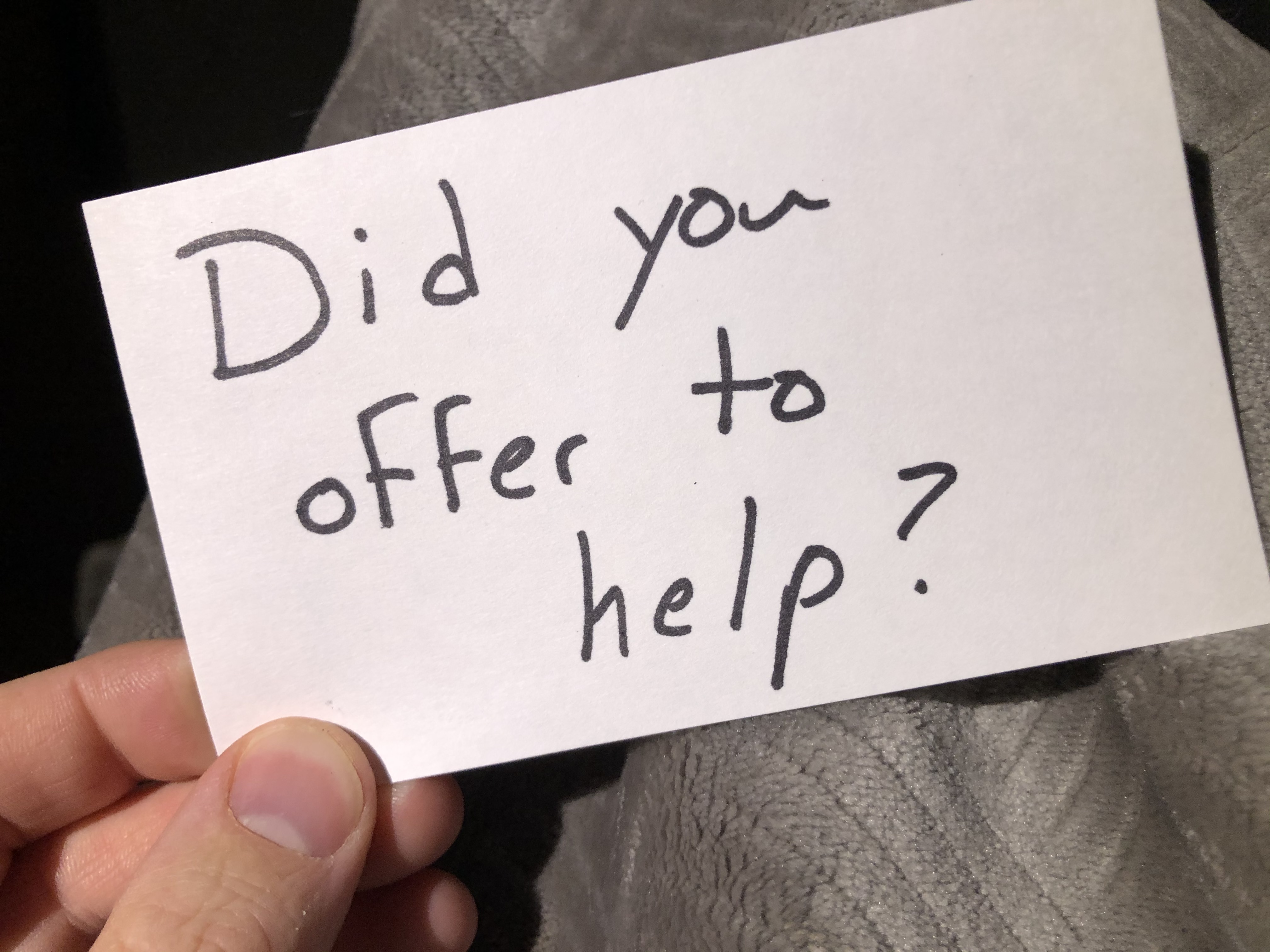10. Dan Levy
9. Brandi Carlile
8 & 7. The Avett Brothers
6. Robert Fulghum
5. Vice President Harris
4. Rainbow Rowell
3. The Most Rev. Michael Curry
2. Sen. Tammy Duckworth
1. George Takei
Who are ten of yours?
10. Dan Levy
9. Brandi Carlile
8 & 7. The Avett Brothers
6. Robert Fulghum
5. Vice President Harris
4. Rainbow Rowell
3. The Most Rev. Michael Curry
2. Sen. Tammy Duckworth
1. George Takei
Who are ten of yours?
I made this for dinner tonight. It was delicious.
The 9yo did not think it was delicious. He also did not have the tools or capacity tonight to say it in a way that was kind. So, it was “gross,” “disgusting,” and “horrible.” I told him it was okay that he didn’t like the food, and that those words hurt my feelings.
And, then he was worried that I would get angry. “Now you’re not going to let me have any food. I am going to starve.”

Not getting any food if you don’t eat what’s for dinner is not a rule in our house. Everyone gets to always know they will be able to eat and no one in our family will ever go hungry.
He just couldn’t see it.
It took a few rounds and several minutes of him balled up on my lap hugging me before we got to the words he needed and thereby a bowl of cereal with bananas. We found the light and our way out.
Then.
Tucking in 11yo, I went to kiss her on her forehead and she moved her head forward. I saw stars and both lips were bloodied. I’m at the foot of the bed taking breaths, remaining calm, quietly saying, “Owwwww.”
She’s at the head of the bed, holding her forehead, ramping up because she’s scared I’m mad at her.
I cannot talk because my mouth hurts.
I pull myself together and hug her. “What do you have in your head that makes it so hard?” I ask in an exaggerated voice. It is enough to tease out a giggle. Light and our way out.
After books and rubbing her back, I get up to go.
“Hey, Zac!”
This is our ritual. She’s trying to find something to hold on to the day, the ritual, the time together. Some nights, the “Hey, Zac!” gets out before she’s thought of what she’s going to say or ask, and I stand in the doorway waiting. Tonight there’s no wait.
11yo: Hey, Zac!
Me: Yes, love?
11yo: You are the best dad ever.
Me: You are the best daughter ever.
11yo: Love you. Goodnight.
We find the light and our way out.
I’m working really hard here. It turns out, when parenting, your children pay particular attention to your non-verbal communication signals and then, get this, respond based on what they interpret those signals to mean.
AND, get this, they’re children, so they don’t have a whole ton of coping mechanisms when they decide what they’ve read in your signals is that you are angry or don’t like them, or don’t love them.
So, this may not surprise you, their reactions tend toward the negative.
I’m working really, really, really hard on something anyone I’ve ever dated will tell you I’m not great at – telling you how I feel when that feeling is not a positive one. My guess is it’s all attached to some pre-coming-out habits.

Being gay felt like it was a bad thing to be. It would, in the very least, make people feel uncomfortable around me. So, to keep those around me comfortable, I’d better stuff that truth way down deep.
Along the way, this rule started to apply to anything I perceived as negative. If I’m angry, that could make someone uncomfortable around me. I’d better do what I did with that other big thing I was worried would make people uncomfortable. Eventually, the habit became so easy to repeat, any negative feeling I might have was internalized so as not to make things rough for others.
Healthy, right?
The good news is I’ve been working on it. The better and slightly more uncomfortable news is being a parent has fast-tracked that process.
When one of my kids asks, “Are you angry at me?” and I respond, “I am not angry at you. I will tell you if I am angry at you,” I damned well better be sure to communicate that when it happens.
In the last few months, I’ve done a lot of telling my kids how I feel. My use of “I statements” is the strongest it’s ever been.
You know what else? I’ve also been following those statements up with, “And that’s okay.” Because, turns out, it is okay when I’m frustrated because someone yelled at me.
The world does not end when I get angry. My ability to love and be loved remains as strong and constant as ever. I can love a person and be infinitely frustrated at that person at the exact same time.
This is a lesson everyone in our family is learning – over and over.
A teacher friend opened up her current events assignment from its previous scope after some family pushback. Current events being what they are, some families sniffed an agenda where there was none. Still, it worried the friend.

She wants her students following contemporary informational texts across a span of time. She wants them tracking how stories are told about a specific event or idea. She is not so much interested in shaping her students’ political leanings.
This was not what the families thought was happening.
She went the route of being less helpful.
Together, her students brainstormed a list of every possible current event they could think of. Everything on the table.
And, just before the brainstorm, a letter home to parents and caregivers.
“Hey,” it said, “your kid is about to start asking questions about the world. It can be about anything happening in said world. Would you help a teacher out and help them pick something that lines up with what you care about as a family?”
I’m paraphrasing.
Then, the students started submitting the topics they thought they might like to dig a bit more deeply on. The swath, my friend has told me, is much wider than could have been imagined.
This does not surprise me. Given the opportunity to ask questions about the world and a little assistance in thinking about which parts of the world, our students will always astound us.
The next thing for these students to do is use the Question Formulation Technique developed by the folx at rightquestion.org to come up with mound and heaps and oodles of questions about their topics. Then, they get to set about the task about finding the answers and, if they’re doing it right, more questions.
The relieved teacher friend and I were talking.
“Of course this is better,” I said, “You’ve proven you don’t care what they think, but that they think and think deeply about their world.”
It doesn’t matter the topic. That skill is transferrable.
My son was closing the medicine cabinet, toothbrush in hand, and smeared toothpaste all over the mirror. He then tried to wash it off by splashing water from the faucet to the mirror. This did not help.
“I don’t know what I’m doing,” he told me as I walked into the bathroom.
“He got toothpaste all over the mirror, then he got water on the mirror, then he started to smear it all over the mirror, then he got it in my sink. Everything he’s doing is making it worse,” his sister said in the tone of voice reserved for older siblings exasperated at their younger siblings.
“Did you offer to help?” I replied.
“I told him he was doing it wrong, and he kept doing it even more wrong!”
“Did you offer to help?”
“No.”
“Next time, will you offer to help?”
“…yes…”
Now, thinking it over, I need that tattooed on the back of my eyelids. I need it as an out-of-office message. I need it in every moment I’m working with someone learning something new, and I need it in any conversation where an adult complains about a child.
If the answer is “yes,” then we are halfway there.
In What on Earth Have I Done? Robert Fulghum writes “I have more than enough. They do not. And here were are, face-to-face.” Fulghum’s words are in an essay tackling the moral and practical question of whether to give money to those asking for it in intersections and on street corners.
It comes down do, “Did you offer to help?”
It is not my job to judge them. It is my job to judge me.
Sure, if I give something to each and all of them, I may in the process give to someone who do not really deserve help. That’s the chance I take, but I will have not missed anyone whose need is real.”
– Robert Fulghum, What on Earth Have I Done?
Teachers will often talk about the real world and withholding assistance or the benefit of the doubt to students because such second chances will not be afforded students in the real world. Most of these conversations concern issues of great import in the fiefdoms of their classrooms. In the grand schemes of students’ lives, they are little, insignificant things. Late work, a missed citation, not showing how you got to your answer. The real world. Ugh. Even the IRS will give you an extension.
Our classrooms are the real world, certainly to the students compelled to be there each day. They are the laboratories of civic and social interactions, imparting implicit and explicit norms of what they should do when life’s training wheels are off. Withholding the offer of help and the benefit of the doubt models behavior our students will surely remember, and mimic, when they reach that mythical real world.
They will not remember the late homework assignment, but they will remember whether we helped when they asked.
What if we were to give to all whom ask? Yes, some will game the system, but that’s the system’s lot to contend with. Ours is to contend with who we’ve shown the world we are each day. Or, as teachers, what we’ve shown our students the world could be each day. “It’s my job to judge me.”
The photo below is of a card now taped to the lamp on my bedside table. I can think of few better questions of accountability to end my day with.

How about a few things I’m grateful for right now?

1. Instant Pot – I used my moms’ digital pressure cooker while we were home in Illinois over the holidays. Then, I was hooked. Through a compilation of gift cards, mine showed up today. I’ve made applesauce – in 8 minutes!!! – and macaroni and cheese with broccoli. I had to cut the children off. There’s only so much cheese and broccoli a body should consume in one sitting. I’m legitimately excited to keep making things. We’re having orange “chicken” later this week. To not have to monitor the brown rice feels like its own gift.
2. Misfits Market – They take the produce grocery stores won’t stock because of physical imperfections and sell it at a discount. We’re two weekly shipments in and I’m pretty happy. It’s increased our fruits and veg in the house, and it’s diversified them. Kale chips, potato soup, the aforementioned applesauce. Plus, it’s fun to have the kids help me build our box each week. I dare say they’re more willing to try the things they helped pick. Who knew choice and control were important?
3. Running – I mentioned I’d be giving it a go a few posts back. Well, I’ve gotten 5 lunchtime runs totaling 11.5 miles since then. My word has it improved my mood and sense of self. Those 11.5 miles are more than I totaled all of 2020. Here’s to more miles and shedding some of the meat suit I feel like I’ve been wearing.
4. People are reading – I have been pretty constantly surprised and humbled by reactions from folx reading these posts. In the same way running has helped me feel connected to myself, writing and seeing responses has connected me beyond the 9 and 11 year olds I spend most of my time with.
5. Pokémon – Each night, after dinner and before books and bed, the three of us watch one or two episodes of Pokémon. With more than 1,100 episodes, we should be set for a few years. While the bulk of the content is episodic, from time to time, a character or scene from an earlier episode will be the focus of a later episode. Listening to the kids recognize this through line of the plot and characters always makes me smile. They are able to do and remember more about the world every day. They’re letting down the defenses that kept that from being able to do that. Keep ’em coming, Ash.
What are your gratefuls?
Sure, a blog post every day feels like a personal return to form. And, geez, I’m loving it. That last post? I wrote, deleted, and re-wrote it three times before I found what I actually wanted to say. So, yes, I’m very much enjoying a return to writing.

And yet.
This is only the public writing I’m used to doing. When it went away, it was accompanied by other forms of writing that brought me great joy. In the Before Times, I would make a point each week of writing thank you notes to a few people across the district with whom I’d interacted that week or who were on my mind as being wonderful human with whom to work.
It is the grown-up version of making sure the last thing I did before leaving school was writing one positive note home for at least two students on my rolls. Knowing the last thing I’d done with my day was putting pen to paper to express my joy in teaching my students helped turn some pretty crap days around.
The rub of it is these are exactly the times when I need to be writing more notes to colleagues. When we are necessarily separated and prohibited from running into each other in the halls on the way to meetings, that’s the time to stop at the end of the week and write.
Maybe you want to get in on the action? Maybe there are some colleagues or students who could do with reading your words of encouragement and gratitude? I’ve just added a calendar event for next Friday and every Friday after. It’s 30 minutes and simply called, “Write Notes.”
Who will you write to first?
We have a family morning meeting. The boy suggested it a few weeks ago. There are three standing questions:
I struggle every morning trying to find a difference between my answers to #1 and #2, but I find a way to make it work. Yesterday, I got to explain optimistic.

More than any of it, I look forward to their answers. Happy is the most often shared feeling in the morning. It’s when we get to #3 that I get a sense of where their brains and priorities are. It bounces around. Sometimes, its seeing friends. Sometimes, it’s a specific friend. It could be as general as “get my work done” or as specific as “tell my teacher you beat the Spider-Man game”. (I did, and I’m equally proud.)
My moments of self-control happen when their responses are vague. It’s all I can do not to ask for more detail to “get my work done.” I hold back because I know that will come. I hold back, and I model that detail in my own response. I know they are listening because we share our progress when I pick them up from school. “Did you write that thing you wanted to write and send the message to your friends at work?” (I did.)
They are playing with goal setting, and I want it to be just that. Our morning meetings are space for them to mess about with checking in on their own feelings in the moment and experiment with setting a course for the day. There are so many parts of their lives when I and other adults ask them to do it differently or better or again or never again. Our morning meetings are a place where I want them to know none of that will happen. It’s a space where whatever answer is the correct answer.
It’s also a space where I try not to say happy all the time. It’s a little tough, because I usually am. When it’s true, though, I’ll say I’m frustrated or anxious or any other more negative emotion. I do it, one, because it’s what I’m feeling, and, two, because I want them to see I or they can feel those things and the world will not end.
“I am feeling anxious because we got out the door late today, and I’m worried we won’t get to school today. I’m feeling hopeful that feeling will pass and the rest of my day will be better.” Something like that.
All of this has also been a little jarring for me. More accommodating than I’d like to admit, I’m much more likely to put my own emotions on the back burner so as not to get in others’ way. It’s a trait I’m actively working not to pass on to my kids. It’s also personal growth I’m trying to make transparent to them. Grown ups learn too.
I hope the other grown ups to whom I entrust them each day are making similar spaces for them. In between math and reading, I hope they have moments surrounded by peers and teachers where the community checks in with itself to see what it needs to support its members.
Mine aren’t the only kids hungry for these spaces. I’m not the only adult who needs to learn how to answer these questions honestly. I hope our schools and classrooms recognize the value and extent to which doing this work can make the academic work so much better.
For those keeping track, I went on another lunch run today. That’s three in the last four work days. Running has always been where I get my thinking done. I ruminate.
Today, I was thinking about classrooms – physical, digital, and those who have yet to make up their minds – and how I know they must be struggling to create the communities that must be established as foundations of learning.
I started thinking about what I would do. I came up with questioning. This is not surprising for a guy who really hangs his hat on inquiry. For this, though, I was trying to think of something a teacher could implement with absolutely no prep and yet reap a deep benefit in shoring up community.
The idea is to challenge students to come up with one good question they would be interested in hearing their peers answer and would be okay with answering themselves. Then, they pair or group up and share their questions and answers.
Sure, sure, there can be reporting out, sharing, and asking who had similar questions or answers. But, there doesn’t need to be. All that’s necessary for community to begin to form is for people to try to find out about one another and to share a piece of themselves.
Not having a classroom of my own, I used our dinnertime conversation as a testing ground this evening. “Think of one good question you want all of us to answer, and we’ll take turns answering.”
They wanted a model, so I went first. “What’s one thing that can almost always make you smile when you are sad?” Tickling was a popular response.
My daughter was next, “What do you like about doing our gratefuls?” Our “gratefuls” are our nightly ritual of putting a coin in a mason jar and sharing at least one thing we are grateful for that day. Hearing what both kids thought about the process was wonderful.
The boy went last, “Are you afraid of heights?”
I had to think about my answer. I wasn’t sure. Turns out, yup, sometimes.
So, with one text audience of kids who will definitely let me know if one of my ideas is bad or stupid, I had a 100% success rate. You will too.
Try it tomorrow. Even if those you’re learning with are adults. All it takes is One Good Question to bring us closer.
I’ve been praying for President Trump.
In the Episcopal faith, there is a portion of the service referred to as the Prayers of the People. In addition to individual petitions and expressions of gratitude offered up each week by parishioners the Book of Common Prayer offers a standard – you might say common – text to be read each Sunday. Included in my congregation’s version are petitions on behalf of our bishop, president, and governor by name.
In Colorado, this presents an interesting trio. Our bishop, Kym Lucas, is an African American woman, our governor, Jared Polis, is a Democrat and an out gay man, and Donald Trump is a Republican and a straight man.
The first time these names aligned following Polis’s inauguration, it hit me as peculiar. No matter who was in the pews, at least one of those names likely represented progress and at least one of those names was problematic.
President Trump’s was the problematic name for me. After his inauguration, the first Sunday his name was uttered, took me by surprise. “Oh,” I thought, “we’re going to pray for him?”
Here was a man who stood for so much of what I work against, and I was praying for him. I struggled with the Prayers of the People for weeks. Each time I knew, “for Donald, our President” was coming, I considered including my own footnote “but not really.”
The ritual of praying for President Trump became a more present and active part of my prayers than all of the rest of it. If I believed we are called to love everyone, it had to mean everyone – even someone whose actions I detest. No caveats. Otherwise, I was no better than those who believed there was no place for me in the church.
That was difficult. Is difficult. But that difficulty kept President Trump human. It kept my arguments against his actions and policies centered on those actual actions and policies.
In her most recent episode of the Unlocking Us podcast, Brené Brown takes on the dangers of dehumanizing words and actions. She shares her own resistance to dehumanizing President Trump. The episode helped me think through much of what the Prayers of the People have helped me practice these last four years.
Next Sunday’s prayers will shift again. Donald will no longer be built into the service. I wonder where I will make space to continue to offer love to someone who has caused so much pain. Will I be strong enough to care for someone I’m all but certain would not care for me?